 |
| |
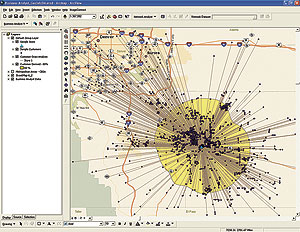
Users can identify their primary trade area based on where most of their customers are located. |
The 9.1 version of ArcGIS Business Analyst desktop analysis software is designed for both GIS and non-GIS professionals in agencies, companies, and organizations who must quickly produce better marketing analyses. ArcGIS 9.1 Business Analyst software's robust integration of data and software provides a series of intuitive, wizard-driven applications that enable users to run simple reports or perform sophisticated analyses and map the results. In addition to wizards that can be used to analyze data for stores, customers, and trade areas, ArcGIS 9.1 Business Analyst contains an integrated model builder with templates and tools to automate the marketing analysis process.
Following is an overview of a few new elements in the ArcGIS 9.1 Business Analyst release:
Complete integration with the ArcGIS 9 framework—The complete integration of ArcGIS 9.1 Business Analyst with the ArcGIS 9 framework provides a new environment for
- Geoprocessing—This function was added to simplify and speed up the production of more complex marketing applications. A comprehensive set of geoprocessing tools is included in the new framework to integrate with all the data formats supported by ArcGIS 9.1 Business Analyst. This flexible geoprocessing framework allows users to launch the tools individually, combine them in a visual modeling environment, write scripts in standard scripting languages, and run the tools as commands in a command line window.
- Modeling—Using ModelBuilder, users can also create models that will execute a sequence of geoprocessing functions. For example, a store layer created in one function can become the input for a trade area function. The integrated ModelBuilder window can be used to view and edit models. This window allows users to drag and drop tools and data into the model diagram to build processes that can be connected into a logical flow. A model can be run and the flow of control inspected from within the ModelBuilder window. Scripts and other models can be included as part of the steps in the models or saved in toolboxes to be used as tools or distributed to other users. Models can be exported from the ModelBuilder window as a script.
| |
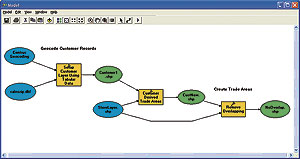
Illustration of a scripted model. |
- Scripting—To author a script easily, select the COM-compliant scripting environments, such as Python, JScript, and VBScript. Scripts can include calls to geoprocessing tools, models, and other scripts. After a script is authored, it can be exposed to users as a standard tool and embedded in other models or scripts similar to any other tool.
Elements and tools specific to the ArcGIS Business Analyst extension within ArcGIS Desktop ArcCatalog and ArcToolbox applications
- ArcCatalog is now used extensively to organize data contained in ArcGIS Business Analyst. The ArcCatalog application organizes and manages all information, such as data for stores, customers, and trade areas. It also organizes information for reports, datasets, models, metadata, and services. Users can employ ArcCatalog to organize, find, and use data from Business Analyst, as well as document data holdings using standards-based metadata. Each element in the Business Analyst section of the ArcCatalog tree can be used in conjunction with ArcToolbox tools or ArcMap. For example, users can drag and drop a Business Analyst store to a geoprocessing tool input element, ModelBuilder, or to a document in the ArcMap application.
| |
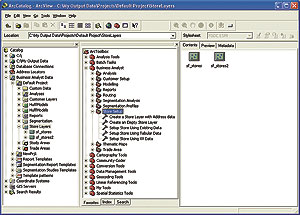
Store layer application using ArcCatalog. |
- The dockable ArcToolbox window has a comprehensive set of tools for all ArcGIS Business Analyst capabilities. This dockable window can be integrated into ArcMap or ArcCatalog. The ArcGIS Business Analyst extension adds more than 70 tools to ArcToolbox. Here's what is included in a toolbox:
- Toolset: A container for organizing the contents of a toolbox.
- Tool: Runs an underlying function in the geoprocessing framework.
- Script: Can be written in any COM-compliant scripting language, such as Python, JScript, or VBScript. An ArcInfo Workstation ARC Macro Language (AML) can also be added into a toolbox as a script.
- Model: Can be viewed and edited in the new, integrated ModelBuilder window.
| |
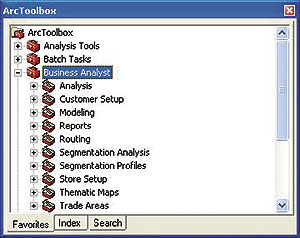
Tools in ArcToolbox. |
Enhanced reporting capabilities include a batch framework and a wizard for creating custom reports. Users can now work with multiple sites, trade areas, and customer files to create new trade areas, reports, and analyses. The results can be a single output or batched together in a group. Report speed has been dramatically improved in ArcGIS 9.1 Business Analyst, and a new set of report export tools has been included. Now users can view their reports on-screen; add a map; have the reports produced in several popular desktop formats, including Adobe Acrobat PDF, HTML, Microsoft Word, and Microsoft Excel; and send them directly to a designated printer.
| |
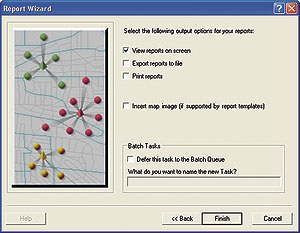
Report Wizard—View, export, or print reports screen. |
Users can also use a wizard to create and manage custom reports based on any data layer, including data in ArcGIS 9.1 Business Analyst or their own data. The wizard allows users to select variables and organize them in a new report template.
Current datasets include
- Esri demographic data—Esri offers more than 1,000 U.S. demographic data variables, including current-year estimates and five-year forecasts. These data variables are augmented by current-year estimates for employee population; population by occupation/industry; disposable income; consumer expenditures, all at the state, county, ZIP Code, tract, block group, Core Based Statistical Area, and Designated Market Area geography levels; and at the census tract level in Esri's segmentation system, Community Tapestry.
- Directory of Major Malls shopping center data—A national database from the Directory of Major Malls lists information for more than 4,450 major shopping centers, malls, and lifestyle/specialty centers in the United States. Data variables include center name, Gross Leasable Area, type of center, total retail sales, distance to the nearest competing center, distance to the nearest major city, nearest major city, and total number of stores. Information is also included for up to three anchor stores, such as store name and square footage.
- infoUSA business data—A national database of approximately 11 million U.S. businesses from infoUSA, Inc., can be used to identify customers or competitors and includes data by industry, sales volume, employees, geography, and more.
- Tele Atlas/TomTom (GDT) street data—Street data from Dynamap Transportation, the flagship product from Tele Atlas/TomTom North America, provides a nationwide basemap for routing and drive-time analysis. This database contains more than 14 million street address segments along with postal boundaries, landmarks, and water features.
| Method | Description | Use To |
| Tool dialog | A form in which input data and other necessary parameters are defined. Full embedded context-sensitive help is provided. | - Run any geoprocessing tool from inside any application.
- Get familiar with a tool and its parameters.
|
| Model | An interactive visual model that links processes, data, and parameters together. Models are created and edited in the integrated ModelBuilder window. | - Build models, work flows, and processes without scripting or programming.
- Document or present a process.
- Explore alternative scenarios.
- Present methodology and workflow to others. |
| Command Line | Dockable command line window offering usage pop-ups for commands, auto-completion, etc. | - Run tools quickly without launching their dialogs.
- Useful a shortcut for advanced users. |
| Script | File written using a standard scripting language such as Python, Jscript, or VB Script. | - Automate repetitive tasks.
- Provide full control of process based on any conditions, states, time delay, etc.
- Allow advanced GIS users in the traditional working environment to access the full range of ArcGIS Desktop functionality. |
| ArcObjects | Geoprocessing objects can be accessed in the ArcGIS development environment to create custom tools and applications using COM-compliant languages like Visual Basic 6, Visual Basic.Net, C++, and C#. |
- Incorporate tools into new and existing applications.
- Create custom dynamic link libraries that incorporate geoprocessing tools.
- Create custom toolbox functions (DLL, EXE, or OCX). |
The underlying data architecture in ArcGIS 9.1 Business Analyst has been improved to include calculated fields. This new feature can calculate new "virtual" fields. For example, the sum of two population variables can be stored as a new variable for use in future analyses and report. New "data join" tools simplify the process of joining information to core ArcGIS 9.1 Business Analyst boundaries. In another example, users can add a table with store sales by ZIP Code and dynamically join this data to the ZIP Code boundaries provided in ArcGIS 9.1 Business Analyst. This joined data can be used in reports, models, and analyses based on the sales data.
| |
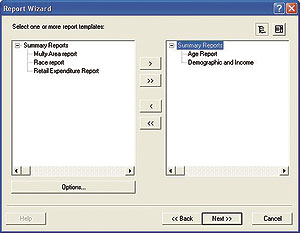
Report Wizard—Report templates. |
For more comprehensive marketing applications, customer and other internal data can also be integrated into ArcGIS 9.1 Business Analyst software's standard data packages.
An optional segmentation module will help target customers, examine merchandise mix, and find optimal locations. This module is based on Esri's segmentation system, Community Tapestry. Using proven segmentation methodology introduced more than 30 years ago, Tapestry classifies U.S. neighborhoods into 65 segments based on their socioeconomic and demographic composition. Tapestry provides an accurate, detailed description of U.S. neighborhoods.
The segmentation module can be used to profile the most profitable customers, identify the best markets, tailor marketing messages to fit the audience, reveal secondary markets, and define product and service preferences. Customer profiles can be compared to other profiles created in the segmentation module. These include trade area profiles, standard geographic area profiles, or profiles based on survey questions from Mediamark Research Inc. After the profile is created, segmentation reports, maps, and charts can be developed with the segmentation module to help identify target groups by Tapestry segment. Users can combine the segmentation analyses with other reports produced in Business Analyst to create a Segmentation Study Book.
| |
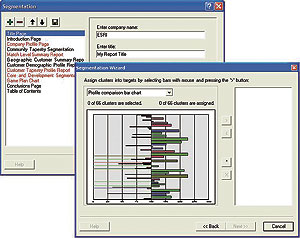
Segmentation Wizard in the optional segmentation module. |
ArcGIS 9.1 Business Analyst contains all the tools and data necessary for users to perform analyses faster for better, more informed business decisions. Analyzing markets, evaluating and selecting sites, and profiling customers and constituents are some marketing analysis applications that can be easily performed with ArcGIS 9.1 Business Analyst.
Complementary products to ArcGIS 9.1 Business Analyst are Business Analyst Online and My Business Analyst Online. These products bring to the Web capabilities previously available only through ArcGIS 9.1 Business Analyst desktop software. These products provide agencies, companies, and organizations with the ability to instantly access data reporting and mapping away from the office or from multiple sites. See related article entitled "Business Analyst Online—Now with 2005/2010 Data and More Capabilities." To learn more about ArcGIS Business Analyst, visit www.esri.com/businessanalyst.
|